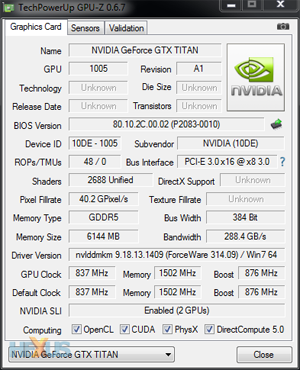Twin TITANs
You've seen what makes it tick, been privy to just how well one TITAN card performs against some ultra-enthusiast competition, but let's face it, leaving the best GeForce without at least seeing what it can do in a multi-card configuration is verging on criminal.
NVIDIA believes GeForce GTX TITAN really comes into its own when run in two- or three-way SLI, for thunderous performance that no other graphics subsystem can match. Sure, you'll need to pay up to £2,500 for the privilege of such graphical barbarism, but when has bleeding-edge performance ever been cheap?
We've put a couple of these muscular TITANs together - £1,600-plus retail pricing notwithstanding - and evaluated how they perform against the crème de la crème of the graphics world.
It's undeniable that a single TITAN is the fastest consumer GPU ever released, and recent two-board SLI performance has provided near-perfect scaling in some titles. Cobble these two facts together and, assuming the base system - CPU and memory - is up to the task of feeding a potential 9TFLOPS of power, performance should be electric.
Test setup
GPU Comparisons |
||||||||
|---|---|---|---|---|---|---|---|---|
| Graphics Card | GPU Clock (MHz) |
Stream Processors |
Shader Clock (MHz) |
Memory Clock (MHz) |
Memory Bus (bits) |
Graphics Driver | Approx Price | |
| NVIDIA GeForce GTX TITAN 6GB SLI | 837 (876) | 2,688 x 2 | 837 (876) | 6,008 | 384 x2 | GeForce 314.09 | £1,660 | |
| NVIDIA GeForce GTX TITAN 6GB | 837 (876) | 2,688 | 837 (876) | 6,008 | 384 | GeForce 314.09 | £830 | |
| NVIDIA GeForce GTX 690 4GB | 915 (1,019) | 3,072 | 915 (1,019) | 6,008 | 256 x 2 | GeForce 314.07 WHQL | £750 | |
| NVIDIA GeForce GTX 680 2GB | 1,006 (1,058) | 1,536 | 1,006 (1,058) | 6,008 | 256 | GeForce 314.07 WHQL | £375 | |
| AMD Radeon HD 7970 GHz 3GB | 1,000 (1,050) | 2,048 | 1,000 (1,050) | 6,000 | 384 | Catalyst 13.2 beta 6 | £350 | |
| Club3D Radeon HD 7990 6GB | 900 | 2,048 x 2 | 900 | 5,500 | 384 x 2 | Catalyst 13.2 beta 6 | £730 | |
| AMD Radeon HD 7970 3GB CrossFire | 925 | 2,048 x 2 | 925 | 5,500 | 384 x 2 | Catalyst 13.2 beta 6 | £600 | |
HEXUS High-End Test Bench |
||||||||||||
|---|---|---|---|---|---|---|---|---|---|---|---|---|
| Processor | Intel Core i7-3770K (3.50GHz, 8MB cache, quad-core) | |||||||||||
| CPU Cooler | Intel reference E97378-001 | |||||||||||
| Motherboard | Gigabyte GA-Z77X-UP4 TH | |||||||||||
| Memory | 8GB G.Skill RipJaws (2x4GB) DDR3 @ 1,600MHz | |||||||||||
| Power Supply | Corsair AX750W | |||||||||||
| Storage Device | Samsung 830 Series 256GB SSD | |||||||||||
| Optical Drive | Generic 24x DVD-RW | |||||||||||
| Chassis | Corsair Graphite Series 600T | |||||||||||
| Monitor | Dell 3007FPW and 3x BenQ EW2430 | |||||||||||
| Operating system | Windows 7 Ultimate (64-bit, SP1) | |||||||||||
There's little doubt that the TITAN SLI duo should win most, if not all, of the benchmarks. Let's see how fast it is, especially in the just-released Crysis 3.










